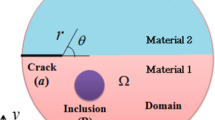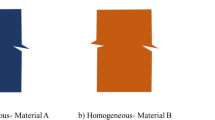Abstract
This study presents the application of the peridynamic differential operator (PDDO) on modeling of bi-material plates with/without modulus graded regions. The PDDO converts the Navier’s equilibrium equations and boundary conditions from the differential form into the integral form. The mismatch of the stiffness along the interface of two distinct materials results in an increase in the strain and stress variations, leading to the onset of cracking at the free corners of the interface. The interfacial strains and stresses can be mitigated by inserting a modulus graded layer between two different materials. The material properties in the modulus graded region is achieved through the power-law distribution. The efficacy of the proposed approach is demonstrated by considering a bi-material square plate under tension. The PDDO displacement, strain, and stress predictions are compared with the reference solutions, and good correlations are achieved. The influence of a modulus graded region with/without a pre-existing crack located between dissimilar materials is investigated for different material variations. It is noted that the PDDO performs very well on the displacement, strain, and stress predictions even if the solution domain has geometrical or material discontinuities. Moreover, modulus graded regions offer some advantages over the sharp interfaces and alleviate the strain and stress concentrations along the interface of the dissimilar materials.














Similar content being viewed by others
References
Wang W, De Freitas ST, Poulis JA, Zarouchas D (2021) A review of experimental and theoretical fracture characterization of bi-material bonded joints. Compos B Eng 206:108537. https://doi.org/10.1016/j.compositesb.2020.108537
Jiang S, Gu Y, Fan C-M, Qu W (2021) Fracture mechanics analysis of bimaterial interface cracks using the generalized finite difference method. Theor Appl Fract Mech 113:102942. https://doi.org/10.1016/j.tafmec.2021.102942
Elishakoff I, Pentaras D, Gentilini C (2016) Mechanics of functionally graded material structures. World Scientific, Singapore
Erdogan F (1995) Fracture mechanics of functionally graded materials. Compos Eng 5:753–770. https://doi.org/10.1016/0961-9526(95)00029-M
Çömez İ, Aribas UN, Kutlu A, Omurtag MH (2021) An exact elasticity solution for monoclinic functionally graded beams. Arab J Sci Eng 46:5135–5155. https://doi.org/10.1007/s13369-021-05434-9
Çömez İ, Aribas UN, Kutlu A, Omurtag MH (2022) Two-dimensional solution of functionally graded piezoelectric-layered beams. J Braz Soc Mech Sci Eng 44:101. https://doi.org/10.1007/s40430-022-03414-0
Li L, Zhang X, Cui W, Liou F, Deng W, Li W (2020) Temperature and residual stress distribution of FGM parts by DED process: modeling and experimental validation. Int J Adv Manuf Technol 109:451–462. https://doi.org/10.1007/s00170-020-05673-4
Baytak T, Bulut O (2022) Thermal Stress in Functionally Graded Plates with a Gradation of the Coefficient of Thermal Expansion Only. Exp Mech. https://doi.org/10.1007/s11340-021-00818-2
Wang X, Chen K (2021) Determination of complex stress intensity factors for interface cracks in bi-material specimens subjected to ununiform stresses. Eng Fract Mech 246:107619. https://doi.org/10.1016/j.engfracmech.2021.107619
Aribas UN, Ermis M, Omurtag MH (2021) The static and stress analyses of axially functionally graded exact super-elliptical beams via mixed FEM. Arch Appl Mech 91:4783–4796. https://doi.org/10.1007/s00419-021-02033-w
Dorduncu M, Apalak MK (2016) Stress wave propagation in adhesively bonded functionally graded circular cylinders. J Adhes Sci Technol 30:1281–1309. https://doi.org/10.1080/01694243.2016.1143147
Kirugulige MS, Kitey R, Tippur HV (2005) Dynamic fracture behavior of model sandwich structures with functionally graded core: a feasibility study. Compos Sci Technol 65:1052–1068. https://doi.org/10.1016/j.compscitech.2004.10.029
Torshizian MR, Kargarnovin MH, Nasirai C (2011) Mode III fracture of an arbitrary oriented crack in two dimensional functionally graded material. Mech Res Commun 38:164–169. https://doi.org/10.1016/j.mechrescom.2011.03.004
Rabczuk T, Belytschko T (2004) Cracking particles: A simplified meshfree method for arbitrary evolving cracks. Int J Numer Methods Eng 61:2316–2343. https://doi.org/10.1002/nme.1151
Tvergaard V (2002) Theoretical investigation of the effect of plasticity on crack growth along a functionally graded region between dissimilar elastic–plastic solids. Eng Fract Mech 69:1635–1645. https://doi.org/10.1016/S0013-7944(02)00051-6
Kubair DV, Bhanu-Chandar B (2007) Mode-3 spontaneous crack propagation along functionally graded bimaterial interfaces. J Mech Phys Solids 55:1145–1165. https://doi.org/10.1016/j.jmps.2006.12.002
Jin Z-H, Paulino GH, Dodds RH Jr (2002) Finite element investigation of quasi-static crack growth in functionally graded materials using a novel cohesive zone fracture model. J Appl Mech 69:370–379. https://doi.org/10.1115/1.1467092
Shim D-J, Paulino GH, Dodds RH (2006) J resistance behavior in functionally graded materials using cohesive zone and modified boundary layer models. Int J Fract 139:91–117. https://doi.org/10.1007/s10704-006-0024-4
Dorduncu M (2020) Peridynamic modeling of delaminations in laminated composite beams using refined zigzag theory. Theor Appl Fracture Mech. https://doi.org/10.1016/j.tafmec.2020.102832
Rabczuk T, Song J-H, Zhuang X (2019) Anitescu C (2019) Extended finite element and meshfree methods, 1st edn. Academic Press, London
Dorduncu M, Barut A, Madenci E, Phan ND (2017) Peridynamic augmented XFEM. In: 58th AIAA/ASCE/AHS/ASC structures, structural dynamics, and materials conference, American Institute of Aeronautics and Astronautics; 2017. https://doi.org/10.2514/6.2017-0656
Noël L, Miegroet LV, Duysinx P (2016) Analytical sensitivity analysis using the extended finite element method in shape optimization of bimaterial structures. Int J Numer Methods Eng 107:669–695. https://doi.org/10.1002/nme.5181
Hu XF, Wang JN, Yao WA (2016) A size independent enriched finite element for the modeling of bimaterial interface cracks. Comput Struct 172:1–10. https://doi.org/10.1016/j.compstruc.2016.05.005
Comi C, Mariani S (2007) Extended finite element simulation of quasi-brittle fracture in functionally graded materials. Comput Methods Appl Mech Eng 196:4013–4026. https://doi.org/10.1016/j.cma.2007.02.014
Jin X, Wu L, Guo L, Yu H, Sun Y (2009) Experimental investigation of the mixed-mode crack propagation in ZrO2/NiCr functionally graded materials. Eng Fract Mech 76:1800–1810. https://doi.org/10.1016/j.engfracmech.2009.04.003
Dirik H, Yalçinkaya T (2018) Crack path and life prediction under mixed mode cyclic variable amplitude loading through XFEM. Int J Fatigue 114:34–50. https://doi.org/10.1016/j.ijfatigue.2018.04.026
Silling SA (2000) Reformulation of elasticity theory for discontinuities and long-range forces. J Mech Phys Solids 48:175–209. https://doi.org/10.1016/S0022-5096(99)00029-0
Cheng Z, Zhang G, Wang Y, Bobaru F (2015) A peridynamic model for dynamic fracture in functionally graded materials. Compos Struct 133:529–546. https://doi.org/10.1016/j.compstruct.2015.07.047
Candaş A, Oterkus E, İmrak CE (2021) Peridynamic simulation of dynamic fracture in functionally graded materials subjected to impact load. Eng Comput. https://doi.org/10.1007/s00366-021-01540-2
Dorduncu M, Barut A, Madenci E (2015) Ordinary-state based peridynamic truss element. In: 56th AIAA/ASCE/AHS/ASC structures, structural dynamics, and materials conference, Kissimmee, Florida: American Institute of Aeronautics and Astronautics; 2015. https://doi.org/10.2514/6.2015-0465
Dorduncu M, Barut A, Madenci E (2016) Peridynamic truss element for viscoelastic deformation. In: 57th AIAA/ASCE/AHS/ASC structures, structural dynamics, and materials conference, San Diego, California: American Institute of Aeronautics and Astronautics; 2016. https://doi.org/10.2514/6.2016-1721
Madenci E, Dorduncu M, Barut A, Phan N (2018) Weak form of peridynamics for nonlocal essential and natural boundary conditions. Comput Methods Appl Mech Eng 337:598–631. https://doi.org/10.1016/j.cma.2018.03.038
Madenci E, Dorduncu M, Barut A, Phan N (2018) A state-based peridynamic analysis in a finite element framework. Eng Fract Mech 195:104–128. https://doi.org/10.1016/j.engfracmech.2018.03.033
Madenci E, Dorduncu M, Phan N, Gu X (2019) Weak form of bond-associated non-ordinary state-based peridynamics free of zero energy modes with uniform or non-uniform discretization. Eng Fract Mech 218:106613. https://doi.org/10.1016/j.engfracmech.2019.106613
Silling SA, Epton M, Weckner O, Xu J, Askari E (2007) Peridynamic states and constitutive modeling. J Elasticity 88:151–184. https://doi.org/10.1007/s10659-007-9125-1
Madenci E, Oterkus E (2014) Peridynamic theory and its applications. Springer, New York
Bobaru F, Foster JT, Geubelle PH, Silling SA (eds) (2017) Handbook of peridynamic modeling. CRC Press Taylor, Boca Raton
Madenci E, Barut A, Dorduncu M (2019) Peridynamic differential operator for numerical analysis. Springer International Publishing, Berlin. https://doi.org/10.1007/978-3-030-02647-9
Dorduncu M, Madenci E (2022) Finite element implementation of ordinary state-based peridynamics with variable horizon. Eng Comput. https://doi.org/10.1007/s00366-022-01641-6
Nguyen HA, Wang H, Tanaka S, Oterkus S, Oterkus E (2021) An in-depth investigation of bimaterial interface modeling using ordinary state-based peridynamics. J Peridyn Nonlocal Model. https://doi.org/10.1007/s42102-021-00058-x
He D, Huang D, Jiang D (2021) Modeling and studies of fracture in functionally graded materials under thermal shock loading using peridynamics. Theor Appl Fract Mech 111:102852. https://doi.org/10.1016/j.tafmec.2020.102852
Yang Z, Oterkus E, Oterkus S (2021) Analysis of functionally graded timoshenko beams by using peridynamics. J Peridyn Nonlocal Model 3:148–166. https://doi.org/10.1007/s42102-020-00044-9
Ozdemir M, Imachi M, Tanaka S, Oterkus S, Oterkus E (2022) A comprehensive investigation on macro–micro crack interactions in functionally graded materials using ordinary-state based peridynamics. Compos Struct 287:115299. https://doi.org/10.1016/j.compstruct.2022.115299
Wang H, Tanaka S, Oterkus S, Oterkus E (2022) Fracture parameter investigations of functionally graded materials by using ordinary state based peridynamics. Eng Anal Boundary Elem 139:180–191. https://doi.org/10.1016/j.enganabound.2022.03.005
Ren H, Zhuang X, Rabczuk T (2017) Dual-horizon peridynamics: a stable solution to varying horizons. Comput Methods Appl Mech Eng 318:762–782. https://doi.org/10.1016/j.cma.2016.12.031
Hu Y, Chen H, Spencer BW, Madenci E (2018) Thermomechanical peridynamic analysis with irregular non-uniform domain discretization. Eng Fract Mech 197:92–113. https://doi.org/10.1016/j.engfracmech.2018.02.006
Dorduncu M, Olmus I, Rabczuk T (2022) A peridynamic approach for modeling of two dimensional functionally graded plates. Compos Struct 279:114743. https://doi.org/10.1016/j.compstruct.2021.114743
Madenci E, Dorduncu M, Gu X (2019) Peridynamic least squares minimization. Comput Methods Appl Mech Eng 348:846–874. https://doi.org/10.1016/j.cma.2019.01.032
Madenci E, Dorduncu M, Barut A, Futch M (2017) Numerical solution of linear and nonlinear partial differential equations using the peridynamic differential operator. Numer Methods Partial Differ Equ 33:1726–1753. https://doi.org/10.1002/num.22167
Dorduncu M (2020) Stress analysis of sandwich plates with functionally graded cores using peridynamic differential operator and refined zigzag theory. Thin Walled Struct 146:106468. https://doi.org/10.1016/j.tws.2019.106468
Dorduncu M, Kaya K, Ergin OF (2020) Peridynamic analysis of laminated composite plates based on first-order shear deformation theory. Int J Appl Mech 12:2050031–2050031. https://doi.org/10.1142/S1758825120500313
Dorduncu M (2020) Peridynamic modeling of adhesively bonded beams with modulus graded adhesives using refined zigzag theory. Int J Mech Sci 185:105866. https://doi.org/10.1016/j.ijmecsci.2020.105866
Kutlu A, Dorduncu M, Rabczuk T (2021) A novel mixed finite element formulation based on the refined zigzag theory for the stress analysis of laminated composite plates. Compos Struct 267:113886. https://doi.org/10.1016/j.compstruct.2021.113886
Kutlu A (2021) Mixed finite element formulation for bending of laminated beams using the refined zigzag theory. Proc Inst Mech Eng Part L J Mater Des Appl 235:1712–1722. https://doi.org/10.1177/14644207211018839
Behera D, Roy P, Madenci E (2021) Peridynamic modeling of bonded-lap joints with viscoelastic adhesives in the presence of finite deformation. Comput Methods Appl Mech Eng 374:113584. https://doi.org/10.1016/j.cma.2020.113584
Acknowledgements
This study has been supported by The Scientific and Technological Research Council of Turkey (TUBITAK) with the project number: 219M207. This support is gratefully acknowledged. Also, Dr. Dorduncu and Dr. Kutlu acknowledge the funding support was granted by the German Academic Exchange Service (DAAD) and TUBITAK-BIDEB under International Post-Doctoral Research Fellowship Programme 2219, respectively.
Author information
Authors and Affiliations
Corresponding author
Ethics declarations
Conflict of interest
The authors declare that they have no conflict of interests in this paper.
Additional information
Publisher's Note
Springer Nature remains neutral with regard to jurisdictional claims in published maps and institutional affiliations.
Appendix
Appendix
According to Eq. (8), the PD differential operator for two-dimensional domains and up to second-order derivatives may be generated by addressing a scalar field's \((f\left( {{\mathbf{x^{\prime}}}} \right) = f\left( {{\mathbf{x + \xi }}} \right))\) Taylor series expansion, in the form:
After multiplying each term in this formula by the PD functions, \(g_{2}^{{p_{1} p_{2} }} ({{\varvec{\upxi}}})\) with \((p_{1} ,p_{2} = 0,1,2)\) and performing integration over the family, \(H_{{\mathbf{x}}}\) of point \({\mathbf{x}}\) results with
The orthogonality property of PD functions, \(g_{2}^{{p_{1} p_{2} }} ({{\varvec{\upxi}}})\) indicated by Eq. (10) can be represented as
Substituting the orthogonality conditions into Eq. (49) yields the explicit representation of the PD forms of the partial derivatives as
The PD functions can be generated in the form of polynomials by regarding Eq. (11):
The weight functions, \(w_{{p_{1} p_{2} }} \left( {\left| {{\varvec{\upxi}}} \right|} \right)\) may be determined as \(w_{{p_{1} p_{2} }} \left( {\left| {{\varvec{\upxi}}} \right|} \right) = w\left( {\left| {{\varvec{\upxi}}} \right|} \right)\) for simplicity yet it is not an obligation. By invoking this option, the orthogonality property of the PD functions demands that
where the PD shape matrix, \({\mathbf{A}}\), the matrix of unknown coefficients, \({\mathbf{a}}\), and the matrix of known constants, \({\mathbf{b}}\) can be given as
and
The determination of PD functions that are orthogonal to each term in the Taylor series expansion is achieved by obtaining the unknown coefficients after performing the operation \({\mathbf{a}} = {\mathbf{A}}^{ - 1} {\mathbf{b}}\), Eq. (48).
Rights and permissions
About this article
Cite this article
Dorduncu, M., Kutlu, A., Madenci, E. et al. Nonlocal modeling of bi-material and modulus graded plates using peridynamic differential operator. Engineering with Computers 39, 893–909 (2023). https://doi.org/10.1007/s00366-022-01699-2
Received:
Accepted:
Published:
Issue Date:
DOI: https://doi.org/10.1007/s00366-022-01699-2




